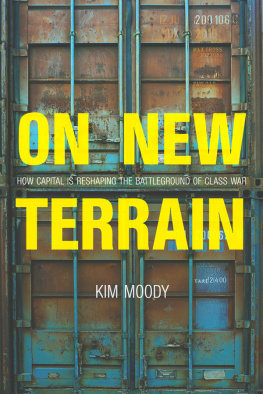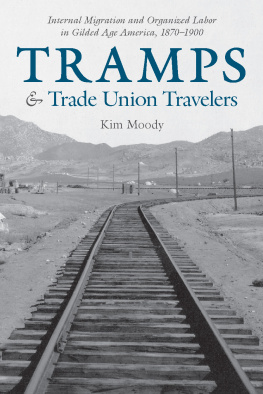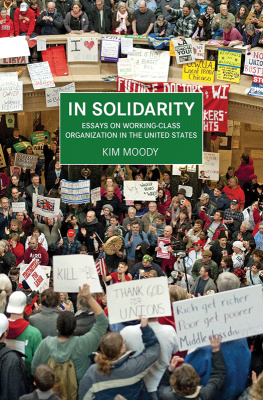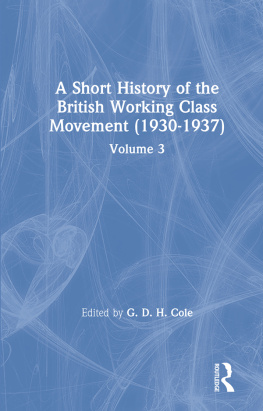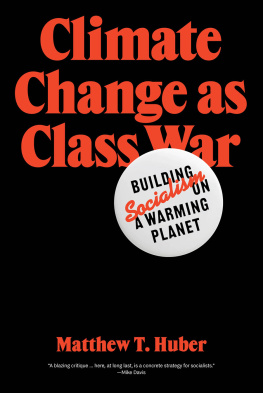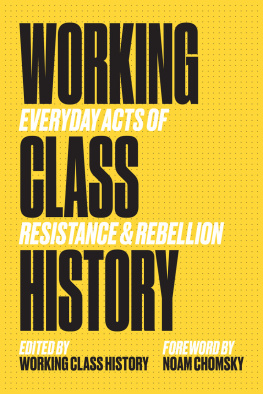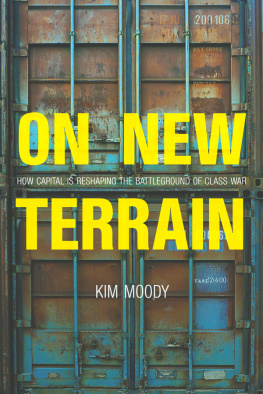ON NEW TERRAIN
How Capital Is Reshaping the Battleground of Class War
KIM MOODY

Haymarket Books
Chicago, Illinois
2017 Kim Moody
Published in 2017 by
Haymarket Books
P.O. Box 180165
Chicago, IL 60618
773-583-7884
www.haymarketbooks.org
ISBN: 978-1-60846-872-0
Trade distribution:
In the US, Consortium Book Sales and Distribution, www.cbsd.com
In Canada, Publishers Group Canada, www.pgcbooks.ca
In the UK, Turnaround Publisher Services, www.turnaround-uk.com
All other countries, Ingram Publisher Services International,
This book was published with the generous support of Lannan Foundation and Wallace Action Fund.
Cover design by Eric Kerl.
Library of Congress Cataloging-in-Publication data is available.

INTRODUCTION
From 1980 through 1982, the world experienced the longest recession since the 1930s. Yet, far from ushering in a prolongation of systemic crisis, this slump laid the basis for a renewed period of capitalist growth and expansion that would last, with ups and downs, until the Great Recession that began in 2008. This new boom could hardly have been more different from the postWorld War II expansion. For this period of growth, spurred by a sharp drop in interest rates, was sustained by the stagnation of wages across the developed economies and a simultaneous and rapid increase in productivity that sent profit rates upward into the new century.
This new era occurred in the context of accelerating globalization, which, measured by both trade and foreign direct investment (FDI), took off in the mid-1980s. The global wage-earning non-agricultural workforce grew from 1.5 billion in 1999 to 2.1 billion in 2013, composing half of the worlds workforce, while despite the Great Recession the number of industrial workers rose from 533.2 million in 1999 to 724.2 million in 2013. Labors share of world income fell in relation to capitals share almost everywhere, largely the result of increased productivity, on the one hand, and stagnant wages, on the other.
All these trends led to a number of developments that are fundamental to the analysis that follows: 1) the increased productivity that led to labors falling share of world income also produced much of the decline in manufacturing employment in the developed economies; 2) global migration brought enormous changes in the ethno/racial composition of the working class in many developed economies; and 3) as a consequence of rising trade and FDI, competition became more intense not only globally but within the major developed economies, leading to an unprecedented business consolidation and the rise of the logistics revolution. These trends would have an enormous impact on the shape of US capitalism in terms of lost manufacturing jobs, rising service employment, the changing ethno/racial composition of the workforce, and the consolidation of business on a massive scale that would alter the terrain of class conflict and the composition and power of the working class itself.
In terms of the changing occupational, industrial, and ethno/racial composition of the US working class, we should remember such changes are an almost continuous process as capital itself expands, contracts, moves, and draws in new human material. For example, as Dan La Botz points out, the Great Lakes industrial region that stretched from Pittsburgh to Chicago and Duluth linked together by a dense network of waterways, railroads, and highways had been the center of industry and industrial unionism and a social texture that supported it until industry began to break up and move after World War II. This is, of course, an important observation about the restructuring of the US working class and the decline of unionism that started even before the neoliberal era that began in the late 1970s as the nations major industrial region became the Rust Belt. At the same time, it has to be kept in mind as well that even during the height of the development of the Great Lakes industrial region and the industrial unions it supported in the 1940s and 1950s, the racial, ethnic, and cultural composition of that class was changing.
The autoworkers who rebelled in the plants of Detroit, Flint, or Lord-stown in the 1960s and 1970s, for example, were not for the most part the descendants of those who founded the United Auto Workers in the 1930s. Many of those in Detroit and Flint of the 1970s were migrants or their offspring from the South, Black and white, who came to these plants in huge numbers during and after World War II. Those young white workers who made the blue-collar blues famous at GMs Lordstown assembly plant came mostly from the rural Midwest to a plant that didnt exist before 1966. Nor by the 1960s were the steel towns of Gary, South Chicago, or Cleveland with their growing black populations the same as they had been in the 1930s. As we will see below, todays working class differs not only in industrial composition and regional concentration from that of the 1960s and 1970s, but in ethnic and racial content as well. The terrain on which the working class and the oppressed fight necessarily changes as the structure and contours of global and domestic capitalism change. It will be argued here that the process of disintegration of the old industrial corridors and regions has been replaced by new and mostly different geographic patterns and structures of concentration with the potential for advances in working-class organization and rebellion.
The late 1970s would see the beginning of the neoliberal era after a decade or more of labor rebellion, low growth, and declining productivity combined with rising inflationknown as stagflation. Characterized by deregulation of industry, privatization of public services, cuts in the welfare state, tax cuts for corporations and the wealthy, undermining of labor rights, and a general emphasis on the market as the salvation of the economy, neoliberalism emerged in the United States as the Democratic Carter administration and Congress defeated labor law reform and passed measures to deregulate truck and air transportation. It would accelerate under Reagan and again under Clinton to become the new norm of economic policy and business preference. Neoliberalism was, as David Harvey has argued, a project to restore class power to the economic elite.
In the period beginning in the 1980s, globalization accelerated, and outsourcing and various forms of workforce flexibility increased, along with internationalized production through global value chains (GVC). These developments appeared to fragment and dissolve the power of the traditional working class across much of the industrial North. Yet, under the very same pressures of global competition, just-in-time-driven logistics systems restructured and integrated the movement of materials within the United States (and around the world), and, beginning in the mid-1990s, the biggest wave of mergers and acquisitions in American history reshaped and consolidated capital as businesses sought to reassert their power in global markets and increase control over the workforce. As a consequence, it will be argued here, capitalism has entered a new phase in which the working class is both restructured and, along with capital itself, consolidated, that is, forced together in new ways.
The argument in this work is divided into three parts. The first part examines the industrial and occupational restructuring of the US working class since the beginning of the neoliberal era in the early 1980s as a result of lean will look at the changes in US politics, the increased importance of the states, the reshaping of the Democratic Party, and the potential for a new radical, class politics in the United States. First, however, the causes of decline in goods-producing employment and the rise of service jobs need to be examined.

